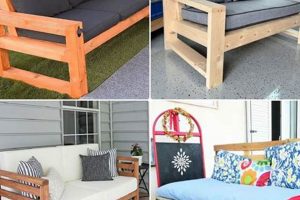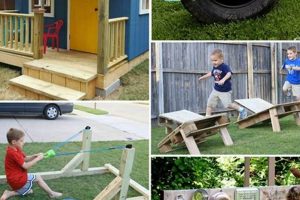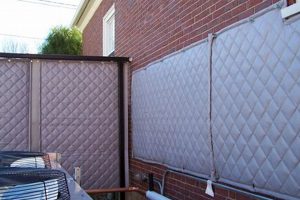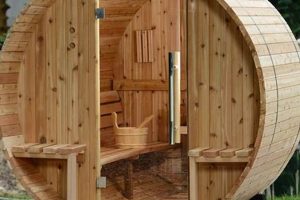A housing designed to shield electrical connections from moisture and external elements, commonly crafted using readily available materials, serves to safeguard outdoor extension cord junctions. Examples include repurposing plastic containers, modifying PVC pipes, or fabricating enclosures with weatherproof seals to protect vulnerable electrical points.
Protection against water ingress prevents short circuits, electrical fires, and potential electrocution hazards, enhancing safety and reliability of outdoor power supply. Such protection extends the lifespan of extension cords and connected devices by minimizing corrosion and damage. Historically, improvised methods for weatherproofing electrical connections predate commercially available solutions, reflecting a long-standing need to adapt electrical systems for outdoor use.
The remainder of this article will address practical methods for constructing robust barriers against environmental factors, outlining materials, tools, and step-by-step instructions. It will also cover considerations for safety, durability, and aesthetic integration with outdoor environments.
Tips for Effective Weatherproofing of Outdoor Electrical Connections
The following recommendations are designed to enhance the durability and safety of field-fabricated enclosures for outdoor electrical connections. Adherence to these guidelines is crucial for minimizing the risk of electrical hazards and equipment damage.
Tip 1: Select Durable Materials: Utilize impact-resistant and UV-stable plastics for the enclosure. Polypropylene or high-density polyethylene offer superior weather resistance compared to thinner, less robust materials.
Tip 2: Ensure a Tight Seal: Employ closed-cell foam weather stripping around the perimeter of the enclosure. This material provides a reliable barrier against water penetration, even under moderate pressure.
Tip 3: Implement Cord Grips: Install cord grips at entry and exit points for the extension cords. Cord grips prevent water from wicking along the cord and entering the enclosure, while also providing strain relief.
Tip 4: Consider Drainage: Incorporate a small drain hole at the lowest point of the enclosure. This allows any accumulated condensation to escape, preventing moisture buildup within the housing.
Tip 5: Elevate the Enclosure: Position the enclosure on a raised platform or mount it to a wall. This minimizes the risk of submersion during periods of heavy rainfall or flooding.
Tip 6: Secure Closure Mechanism: Opt for a latching mechanism that provides a positive seal and is resistant to accidental opening. Hinged enclosures with secure latches are preferable to simple snap-fit designs.
Tip 7: Regularly Inspect and Maintain: Periodically examine the enclosure for signs of wear, damage, or degradation. Replace weather stripping and cord grips as needed to maintain a watertight seal.
By implementing these strategies, the risk of electrical hazards associated with outdoor extension cords can be significantly reduced, ensuring a safer and more reliable power supply for outdoor applications.
The subsequent section will provide detailed instructions for constructing a weatherproof enclosure, incorporating these recommendations into a practical, step-by-step guide.
1. Material Selection
Material selection for field-fabricated housings directly influences their capacity to protect electrical connections from environmental stressors. The choice of material dictates the enclosure’s durability, resistance to water ingress, and longevity in outdoor conditions.
- UV Resistance
Polymeric materials exposed to ultraviolet radiation may undergo degradation, leading to brittleness, cracking, and diminished structural integrity. Materials such as UV-stabilized polypropylene or polyethylene are formulated to resist UV damage, thereby extending the lifespan of the enclosure. Unprotected plastics will degrade, compromising the enclosure’s ability to provide effective protection.
- Impact Resistance
Outdoor environments present the risk of impacts from falling objects, debris, or accidental contact. Materials with high impact resistance, such as polycarbonate or high-density polyethylene, can withstand these forces without fracturing or compromising the enclosure’s seal. Lower-impact plastics are susceptible to cracking, potentially exposing the electrical connections to moisture.
- Water Impermeability
The primary function of a weatherproof enclosure is to prevent water from reaching the electrical connections. Materials that are inherently water-impermeable, such as certain types of rubber or sealed plastics, are essential. Porous or absorbent materials are unsuitable as they allow water to penetrate, leading to corrosion and electrical hazards.
- Temperature Stability
Outdoor temperatures can fluctuate significantly. The chosen material must maintain its structural integrity and sealing properties across a wide range of temperatures. Materials that become brittle at low temperatures or soften at high temperatures are inappropriate for outdoor use. Thermoplastics with a wide operating temperature range are generally preferred.
Proper material selection is a fundamental prerequisite for creating a durable and effective weatherproof housing for outdoor electrical connections. Failure to consider these material properties can result in premature failure of the enclosure, compromising safety and increasing the risk of electrical hazards.
2. Sealing Integrity
Maintaining a continuous and impermeable barrier against moisture intrusion constitutes a critical requirement for any field-fabricated housing intended to protect outdoor electrical connections. Sealing integrity directly impacts the safety and functionality of the entire electrical system.
- Gasket Material Selection
The selection of gasket material for mating surfaces is paramount. Closed-cell foam gaskets, silicone seals, or rubber O-rings provide effective barriers against water ingress, provided they are compatible with the enclosure material and ambient temperature range. Inappropriate gasket materials may degrade or fail, compromising the seal.
- Surface Preparation
Proper surface preparation of mating surfaces ensures a tight and reliable seal. Surfaces must be clean, dry, and free from debris or contaminants that could interfere with the gasket’s contact. Rough or uneven surfaces can create pathways for water intrusion, necessitating thorough surface preparation prior to gasket installation.
- Compression Force
Adequate compression force on the gasket is essential for achieving a watertight seal. Over-compression can damage the gasket, while insufficient compression may leave gaps for water penetration. The correct compression force should be specified by the gasket manufacturer and maintained through appropriate fastener torque or clamping pressure.
- Joint Design
The design of the joint between enclosure components significantly affects sealing integrity. Tongue-and-groove joints or overlapping flanges provide enhanced protection against water intrusion compared to simple butt joints. Interlocking features further improve the joint’s resistance to water penetration, especially in environments with high wind or pressure.
The interplay of these elements directly influences the overall effectiveness of weatherproofing electrical connections. Compromised sealing integrity negates the benefits of other protective measures, such as robust enclosure materials or elevated placement, underscoring the critical importance of careful attention to each detail when constructing a housing.
3. Cord Strain Relief
Cord strain relief, in the context of field-fabricated housings for outdoor electrical connections, represents a critical safety and durability consideration. It directly mitigates mechanical stress on electrical conductors and connection points, enhancing the overall reliability of the system.
- Protection of Electrical Connections
Strain relief mechanisms prevent the direct transfer of tensile forces to the internal wiring and terminals within the enclosure. Without adequate strain relief, repeated pulling or tension on the extension cord can loosen connections, leading to intermittent electrical contact, overheating, or potential short circuits. Commercially available cord grips or improvised methods using knots and clamps serve to anchor the cord and dissipate tensile stress.
- Prevention of Water Ingress
Effective strain relief also contributes to maintaining a watertight seal around the cord entry point. Securely anchoring the cord prevents it from being pulled or displaced, which could compromise the integrity of the seal and allow moisture to enter the enclosure. Cord grips designed with integrated sealing features provide both strain relief and a waterproof barrier.
- Extending Cord Lifespan
By minimizing mechanical stress on the cord itself, strain relief measures extend the operational lifespan of the extension cord. Repeated bending and flexing near the connection point can cause the cord’s insulation to degrade and the conductors to fatigue, leading to premature failure. Adequate strain relief distributes these stresses more evenly along the cord’s length, reducing the risk of damage.
- Compliance with Safety Standards
While field-fabricated housings may not be subject to formal certification standards, incorporating strain relief principles aligns with established safety practices for electrical installations. Proper strain relief helps to ensure that the electrical connections remain secure and reliable under normal operating conditions, minimizing the risk of electrical hazards.
The integration of robust cord strain relief mechanisms into the construction of a field-fabricated housing represents a prudent approach to ensuring the long-term safety and reliability of outdoor electrical connections. The benefits extend beyond mere protection against mechanical damage, contributing to enhanced electrical safety and extended equipment lifespan.
4. Drainage Provision
Drainage provision, within the context of a field-fabricated weatherproof housing for outdoor electrical connections, represents a crucial, often overlooked, aspect of long-term reliability and safety. While the enclosure aims to prevent water ingress, internal condensation or incidental water intrusion remains a possibility. Adequate drainage mechanisms address this contingency, mitigating potential hazards.
- Condensation Mitigation
Temperature fluctuations can lead to condensation forming inside the enclosure. This moisture can accumulate on electrical components, leading to corrosion and short circuits. A small drainage hole at the lowest point of the enclosure allows this condensation to escape, preventing moisture buildup. The size of the hole must be carefully considered to allow drainage without compromising the overall weather resistance.
- Accidental Water Intrusion
Despite best efforts, a perfect seal may not always be achievable or maintained over time. Incidental water intrusion from rain driven by wind or splashing can occur. A drainage provision offers a route for this water to exit, preventing it from pooling around electrical connections. This is particularly important in environments prone to heavy rainfall or flooding.
- Material Compatibility Considerations
The material chosen for the enclosure can influence the need for drainage. Some materials are more prone to condensation than others. Also, some materials such as metal can accelerate galvanic corrosion when wet. A well-designed drainage system can help minimize the impact of these issues by removing moisture before it can cause significant damage.
- Drainage Hole Design
The design of the drainage hole is a critical factor. It must be large enough to allow water to escape freely but small enough to prevent insects or debris from entering the enclosure. Shielding the hole with a small overhang or using a hydrophobic mesh can further enhance its effectiveness. The location of the hole must also be carefully considered to ensure it is at the lowest point of the enclosure, regardless of its orientation.
The provision for drainage, therefore, acts as a failsafe, complementing the primary water-resistant design of a field-fabricated enclosure. It addresses the inevitable realities of outdoor use, where complete prevention of moisture is often impractical, thereby promoting the longevity and safety of the protected electrical connections.
5. Elevated Placement
Elevated placement, as a design consideration for field-fabricated weatherproof housings, directly impacts the effectiveness of protecting outdoor electrical connections. Positioning a housing above ground level minimizes the risk of submersion during periods of heavy precipitation or flooding. This strategic elevation effectively reduces exposure to standing water, which can compromise the integrity of the enclosure and lead to electrical hazards.
Consider a common scenario: a ground-level extension cord connection powering holiday lights. If a sudden downpour causes water to pool, a non-elevated, even supposedly weatherproofed, connection risks submersion. This submersion creates a direct pathway for water to infiltrate the housing, potentially causing a short circuit or posing an electrocution risk. Conversely, if the connection is elevated just a few inches above the typical water line, the risk of water damage is significantly reduced. This simple act of elevation acts as a critical supplementary defense against environmental factors, reinforcing the intended protection. It also reduces the rate of corrosion in the event water breaches the sealing.
In conclusion, elevated placement represents a fundamental and cost-effective strategy to enhance the functionality and safety of field-fabricated electrical connection housings. While constructing a robust enclosure is important, the simple act of elevating that enclosure to minimize contact with standing water provides an additional layer of protection. Challenges may include finding suitable mounting points or fabricating stands, but the benefits in terms of enhanced safety and reliability outweigh these minor difficulties. Elevated placement complements the weatherproofing efforts and is an indispensable component of a safe and durable outdoor electrical setup.
6. Secure Closure
Secure closure mechanisms are integral to the functionality of a field-fabricated weatherproof housing for outdoor electrical connections. They ensure that the enclosure remains sealed and prevents environmental elements from compromising the internal electrical components. A compromised closure negates other weatherproofing efforts.
- Type of Latching Mechanism
The selection of the latching mechanism determines the enclosure’s resistance to accidental opening or disengagement due to environmental factors or physical stress. Options include snap-fit closures, screw-down latches, or hinged mechanisms with locking clasps. Screw-down latches or hinged mechanisms with locking clasps offer a higher degree of security compared to snap-fit closures, particularly in environments prone to strong winds or tampering. For example, a plastic container with a snap-fit lid may be sufficient for light-duty applications, but a metal enclosure with cam-over latches provides superior security and weather resistance for demanding outdoor environments.
- Material Durability of Closure Components
The materials used in the construction of the closure mechanism must withstand exposure to outdoor conditions without degradation. Components made from corrosion-resistant materials such as stainless steel or UV-stabilized plastics prevent rust, cracking, or embrittlement. A zinc-plated steel latch, for instance, may corrode rapidly in a coastal environment, compromising the closure’s effectiveness. A stainless-steel latch, however, offers superior corrosion resistance and maintains its integrity over time.
- Compression Force and Sealing Effectiveness
A secure closure maintains adequate compression force on the enclosure’s sealing surfaces, ensuring a continuous and watertight seal. The latching mechanism must be capable of applying sufficient pressure to compress the gasket material without over-stressing the enclosure components. An improperly adjusted latch may fail to provide adequate compression, leading to gaps in the seal and allowing water intrusion. A well-designed latching system distributes pressure evenly across the sealing surface, maximizing its effectiveness.
- Tamper Resistance
In certain environments, the closure mechanism may need to resist tampering or unauthorized access. Features such as recessed latches, locking mechanisms, or tamper-evident seals can deter unauthorized access to the electrical connections. A simple snap-fit closure offers minimal tamper resistance, while a hinged enclosure with a padlock hasp provides a higher level of security. Tamper resistance is particularly important in public areas or locations where electrical equipment may be vulnerable to vandalism.
The interrelation between these aspects ensures that the “diy waterproof outdoor extension cord cover” reliably protects the underlying electrical connections. A compromised closure can negate any other protective measure, underscoring the critical importance of a carefully selected and robust closure mechanism.
7. Regular Inspection
Scheduled examination of field-fabricated housings is crucial to maintain the protective capabilities designed to safeguard outdoor electrical connections. Over time, environmental factors and physical stress can degrade the materials and compromise the integrity of these housings. Regular inspection facilitates early detection of potential failures, enabling timely repairs and preventing electrical hazards.
- Material Degradation Assessment
Inspection should include a thorough examination of the enclosure material for signs of UV degradation, cracking, or embrittlement. For instance, a plastic enclosure exposed to prolonged sunlight may become brittle and prone to cracking, reducing its ability to shield the electrical connections from moisture. Timely identification of such degradation allows for the replacement of the housing before a breach occurs.
- Seal Integrity Verification
The condition of gaskets, seals, and cord grips must be routinely assessed to ensure they maintain a watertight barrier. A cracked or deteriorated gasket around the enclosure lid or a loose cord grip can permit water ingress, creating a potential short circuit hazard. Careful visual inspection and tactile examination can reveal compromised seals, prompting replacement or repair.
- Drainage System Functionality Check
Drainage holes should be inspected to ensure they are free from obstructions and functioning effectively. Blocked drainage holes can lead to water accumulation within the enclosure, increasing the risk of corrosion and electrical faults. Clearing debris from drainage holes is a simple but crucial maintenance task.
- Mechanical Component Evaluation
Latches, hinges, and other mechanical components must be inspected for proper operation and structural integrity. A broken latch or a corroded hinge can compromise the closure of the enclosure, exposing the electrical connections to the elements. Replacing worn or damaged mechanical components ensures that the enclosure remains securely sealed.
These facets of regular inspection are essential for maintaining the reliability and safety of outdoor electrical connections protected by field-fabricated housings. The proactive approach of routine examination allows for early detection and remediation of potential problems, minimizing the risk of electrical hazards and extending the lifespan of the protective enclosure.
Frequently Asked Questions
The following questions address common concerns regarding the construction and deployment of enclosures designed to protect outdoor electrical connections. These answers provide information to enhance understanding and promote safe practices.
Question 1: What constitutes a genuinely weatherproof enclosure for outdoor electrical connections?
A truly weatherproof enclosure must prevent water ingress under various conditions, including rainfall, splashing, and condensation. The enclosure material must be resistant to UV degradation and physical impact. Sealing integrity at all joints and cord entry points is essential, coupled with adequate drainage provisions for any accumulated moisture.
Question 2: Is it safe to submerge a field-fabricated enclosure designed to protect electrical connections?
Submersion is not recommended, even for enclosures designed with weatherproof features. While the enclosure may prevent water ingress under normal conditions, prolonged submersion can compromise the seals and lead to electrical hazards. Elevated placement is recommended to minimize the risk of submersion.
Question 3: How frequently should field-fabricated electrical connection housings be inspected?
Regular inspections are crucial for maintaining the effectiveness of weatherproof enclosures. Inspections should be conducted at least quarterly, or more frequently in harsh environments, to identify any signs of material degradation, seal compromise, or drainage blockage. Proactive inspection allows for timely repairs and prevents potential hazards.
Question 4: Can any type of plastic container be used for constructing a weatherproof enclosure?
Not all plastic containers are suitable for constructing weatherproof enclosures. The plastic must be UV-resistant, impact-resistant, and non-reactive with electrical components. Thin or brittle plastics are prone to cracking and degradation, compromising their ability to protect electrical connections. Polypropylene or high-density polyethylene are generally preferred due to their durability and weather resistance.
Question 5: What is the purpose of a drainage hole in a weatherproof enclosure?
A drainage hole allows accumulated condensation or incidental water intrusion to escape from the enclosure. This prevents moisture buildup, which can lead to corrosion and electrical short circuits. The drainage hole must be small enough to prevent insect entry and shielded to minimize direct water ingress.
Question 6: Is strain relief necessary for cords entering a weatherproof enclosure?
Yes, strain relief is essential for preventing mechanical stress on the electrical connections within the enclosure. Without strain relief, repeated pulling or tension on the cord can loosen connections, leading to intermittent electrical contact or potential short circuits. Cord grips or other anchoring mechanisms should be used to secure the cord and distribute stress evenly.
These answers emphasize the importance of careful material selection, robust construction techniques, and regular inspection to ensure the safety and reliability of field-fabricated housings. Neglecting these considerations can negate the intended benefits and increase the risk of electrical hazards.
The subsequent section will offer step-by-step instructions for constructing a reliable and durable housing, integrating the principles discussed in the FAQs.
Conclusion
This article has provided an in-depth exploration of “diy waterproof outdoor extension cord cover” solutions, emphasizing the importance of material selection, sealing integrity, strain relief, drainage, elevated placement, secure closure, and regular inspection. Adherence to these principles is paramount for ensuring the safety and longevity of outdoor electrical connections.
The responsible construction and maintenance of these protective housings represent a critical aspect of electrical safety. Neglecting these considerations can lead to hazardous situations and equipment damage. Therefore, diligent application of the information presented herein is strongly encouraged to minimize risk and promote reliable outdoor power delivery.







